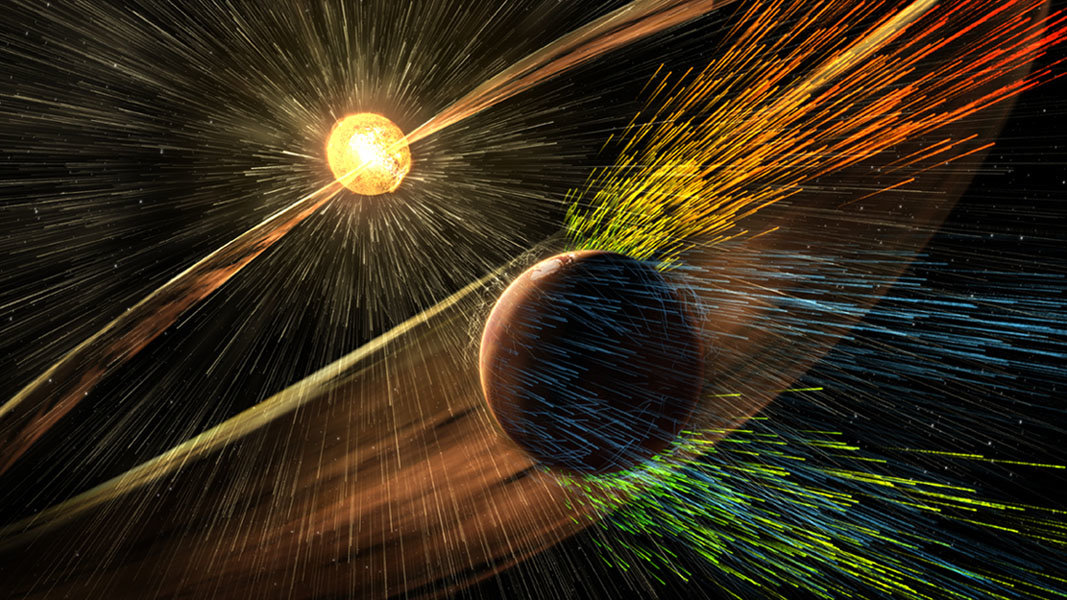New Data From Mars Further Dampens Prospects for Life Around Red Dwarf Stars

Could a Mars-like planet be habitable if it was orbiting a red dwarf star that is cooler and less bright than our sun? New calculations — based on data from a NASA Mars orbiter — suggest the window for life would be short.
The activity on these red dwarf stars could shorten the time during which habitable conditions exist on a planet by a factor of about 5 to 20, the researchers said. In the worst case, extremely active stars could shorten habitability by at least a factor of 1,000 — barely any time for life to establish itself, let alone thrive.
The news comes in the wake of a separate study of Proxima Centauri b, a rocky planet that orbits a red dwarf star just four light-years from Earth. When the planet was discovered in 2016, researchers were initially excited by Proxima Centauri b, a planet orbiting in its star’s habitable zone. However, a new study concluded that habitability would be tough to come by because the red dwarf that Proxima Centauri b orbits likely stripped away the planet's atmosphere over time.
Together, the two studies indicate that the idea of habitability — usually defined as the zone around a star in which liquid water can exist on a rocky planet — needs revisiting, as this zone can be greatly altered by factors such as a planet's atmosphere or a star's activity.
"Habitability is one of the biggest topics in astronomy, and these estimates demonstrate one way to leverage what we know about Mars and the Sun to help determine the factors that control whether planets in other systems might be suitable for life," said Bruce Jakosky, the principal investigator of MAVEN, the Mars Atmosphere and Volatile Evolution mission.
RELATED: The Exoplanet Most Likely to Support Alien Life Might Not Be Habitable After All
MAVEN has been orbiting Mars since September 2014, studying the rate of atmospheric loss from the Red Planet. Mars doesn't have a global magnetic field. This means that over time charged particles from the sun can strip away lighter molecules in the atmosphere.
Breaking space news, the latest updates on rocket launches, skywatching events and more!
For Mars, that process might have had devastating consequences for life. Geological evidence shows that water used to flow on the Martian surface billions of years ago. Since water is a key ingredient of habitability, some researchers suggest that life could have flourished in the past, but only briefly until the atmosphere became too thin to support water and the surface permanently dried up.
A new study, presented Dec. 13 by MAVEN co-investigator David Brain at the fall meeting of the American Geophysical Union, uses data from MAVEN to better understand habitable rocky planets orbiting other stars.
Since MAVEN arrived at Mars, the sun's activity has varied — sometimes experiencing peaks such as solar storms, solar flares, and coronal mass ejections (ejections of solar particles into space). MAVEN monitored how quickly molecules from the Martian atmosphere escaped.
Brain and his colleagues then applied the data to a theoretical Martian-sized planet at the edge of the habitable zone of a red dwarf star, the most common type of star in our galaxy.
A planet orbiting a red dwarf star needs to huddle closer to that star (compared to our own sun) to get enough light and warmth for water to run on its surface, they found. But this comes at a price: The hypothetical planet would receive 5 to 10 times more ultraviolet radiation than Mars does. This radiation would in turn fuel atmospheric escape at a much greater rate than Mars experiences — 3 to 5 times as many charged particles, and 5 to 10 times more neutral particles.
The charged particles would also contribute to a separate atmospheric loss phenomenon called sputtering, which occurs when energetic particles crash into the atmosphere and disturb molecules, propelling some of them out into space.
RELATED: Newly Found Planet Just 11 Light-Years From Earth Could Be Best Bet for Life
But the planet would experience only about the same amount of thermal escape, which happens for lighter molecules like hydrogen. Thermal escape happens at the top of the atmosphere. On the theoretical Mars-like planet at a red dwarf star, the rate of thermal escape only increases if UV radiation moves more hydrogen to the top of the atmosphere, the researchers found.
The researchers added, however, that a planet might have other geological processes that could fight back against atmospheric loss. Perhaps it has a stronger magnetic field, unlike Mars, or active geology that could replenish the atmosphere. Also, planets larger than Mars could better maintain their atmospheres because of stronger gravity.
NASA is launching the James Webb Space Telescope in 2019, which will help researchers better understand habitability. The telescope will get a closer look at huge planetary atmospheres generally, although looking at smaller, rocky planets will likely require more advanced technology.
Meanwhile, at least one study suggests hope for a planet orbiting a red dwarf star. An Earth-mass planet, Ross 128b, orbits a quieter red dwarf star just 11 light-years from Earth. A study released in November suggests that because the stellar activity is subdued, Ross 128b may be the best bet for life close to us.
Originally published on Seeker.

Elizabeth Howell (she/her), Ph.D., was a staff writer in the spaceflight channel between 2022 and 2024 specializing in Canadian space news. She was contributing writer for Space.com for 10 years from 2012 to 2024. Elizabeth's reporting includes multiple exclusives with the White House, leading world coverage about a lost-and-found space tomato on the International Space Station, witnessing five human spaceflight launches on two continents, flying parabolic, working inside a spacesuit, and participating in a simulated Mars mission. Her latest book, "Why Am I Taller?" (ECW Press, 2022) is co-written with astronaut Dave Williams.
